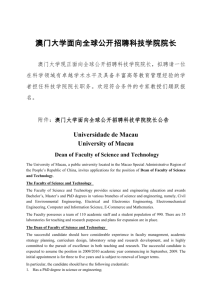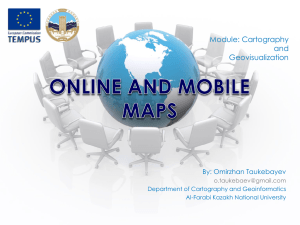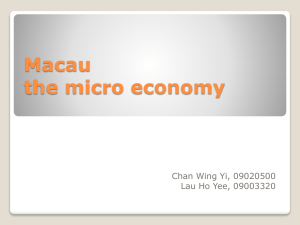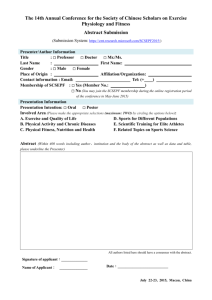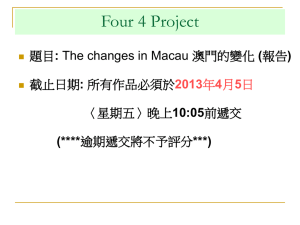University of Macau is located on a hill in Taipa, which is the center
advertisement
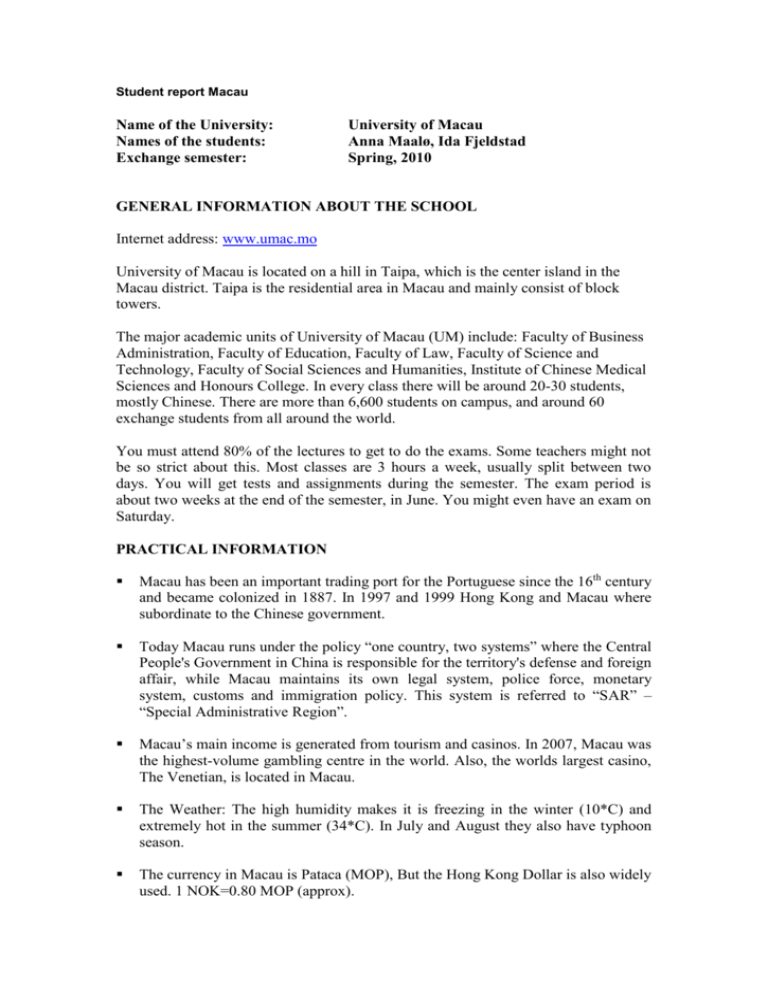
Student report Macau Name of the University: Names of the students: Exchange semester: University of Macau Anna Maalø, Ida Fjeldstad Spring, 2010 GENERAL INFORMATION ABOUT THE SCHOOL Internet address: www.umac.mo University of Macau is located on a hill in Taipa, which is the center island in the Macau district. Taipa is the residential area in Macau and mainly consist of block towers. The major academic units of University of Macau (UM) include: Faculty of Business Administration, Faculty of Education, Faculty of Law, Faculty of Science and Technology, Faculty of Social Sciences and Humanities, Institute of Chinese Medical Sciences and Honours College. In every class there will be around 20-30 students, mostly Chinese. There are more than 6,600 students on campus, and around 60 exchange students from all around the world. You must attend 80% of the lectures to get to do the exams. Some teachers might not be so strict about this. Most classes are 3 hours a week, usually split between two days. You will get tests and assignments during the semester. The exam period is about two weeks at the end of the semester, in June. You might even have an exam on Saturday. PRACTICAL INFORMATION Macau has been an important trading port for the Portuguese since the 16th century and became colonized in 1887. In 1997 and 1999 Hong Kong and Macau where subordinate to the Chinese government. Today Macau runs under the policy “one country, two systems” where the Central People's Government in China is responsible for the territory's defense and foreign affair, while Macau maintains its own legal system, police force, monetary system, customs and immigration policy. This system is referred to “SAR” – “Special Administrative Region”. Macau’s main income is generated from tourism and casinos. In 2007, Macau was the highest-volume gambling centre in the world. Also, the worlds largest casino, The Venetian, is located in Macau. The Weather: The high humidity makes it is freezing in the winter (10*C) and extremely hot in the summer (34*C). In July and August they also have typhoon season. The currency in Macau is Pataca (MOP), But the Hong Kong Dollar is also widely used. 1 NOK=0.80 MOP (approx). Information before we left We received emails with information about almost everything before we came to Macau, such as the school address, how to get there and information about the other exchange students. The only difficulties were to find the courses. The UMAC webpage was quite blurry about their courses, so it was a bit hard to fill out the Learning Agreement from BI. Visa Procedure and travel experiences To get to Macau from Oslo, it might be most convenient to book the plane tickets to Hong Kong, not directly to the airport in Macau. The airport in HK is located outside the city centre, and you can take the ferry directly from the airport to Macau. The price is about 150HKD one way. To get to campus in Taipa, take a taxi or a bus. Note that the taxi driver probably don’t understand English, so bring the address in Chinese (you’ll receive it with the information package from UMAC). The drive takes about 10 minutes and the price from the harbor to the dormitory is about 5060MOP. The price on the bus is 4.2MOP and it takes up to 30 minutes to get there. As a Norwegian citizen there is no need for visa application before arriving in Hong Kong or Macau. At the border you will be granted a 3 month tourist visa and it is free of charge. Sometime early in the semester, Grace, your UMAC contact as an exchange student, will guide all the students through the Student Visa application process. Hong Kong is about 1 hour away from Macau by boat. The boats departure frequently, and 24 hrs, and the price is about 150MOP one way. It is a lot of fun to go to Hong Kong in the weekends to party. In the weekends it is quite popular for students and the Macanese to travel to Mainland China. The Visa application process for Mainland China differs from the one in the “SAR” – areas. You can easily apply for a 3 day visa on the border, or the multiple entry visa at the Chinese embassy. The prizes were about 150/400NOK. Just remember to apply for multiple entry visa early in the semester, as you need 3 months left of your study in Macau in order to get it! It is quite easy to get around in Asia from the airport in Macau. There are flights to most of the big cities in the region. The most popular airline companies are; “Air Asia”, “Philippine Airline” and “FlyVivaMacau”. The prices on the tickets are quite reasonable. A two-way ticket to almost any destination in South-East Asia should be 1000-2000 NOK, sometimes less. As a Norwegian citizen, you don’t need visas for most countries, but remember to check before ordering the ticket! Reception The university had people waiting for us at the dormitory, so the initial reception was good. However, the rooms at the dormitory were dirty, and we were told to clean it ourselves. Apparently they hadn’t done a good job of checking the rooms when the previous students moved out. The dormitories in Macau compares to the studenthousing at Kringsjå, but the standards were a little bit lower in Macau. In spring all the walls will be covered in mold, because of the humid weather, but this is the same in private housing as in the dormitories. Just remember to let the aircondition run, then your room will be nearly free of mold! The introduction week program in was good. During the days we had short lectures about Macau and the Chinese culture, and other activities such as sightseeing in Macau. In the evenings we ate at different restaurants every night, so we got to try a lot of famous Chinese food as well as international dishes. After the dinners we went to different parties. So the exchange student really got to know each other. The enrollment in the courses was a bit of a job. We had to select all the courses individually to a time schedule. Some of the courses previously approved by BI in the learning agreement was cancelled or didn`t fit the time schedule. The reception from the Chinese and Macanese students varied a lot. The Chinese buddies, who participated during the introduction week were really friendly and very helpful. In differ to some of our classmates, in a number of courses we had projects where we had to work in groups with the locals, and a lot of the time they were a bit sceptical towards foreigners or they tried to exploit you with their work load. And they didn’t always speak English during work discussions, since their English level is quite low, something that made some of the projects a bit of a challenge. Either way, we all learned a lot from working together. Housing (Ida lived off-campus in private apartment, while Anna lived on-campus at East Asia Hall.) The University provides exchange students with dorms at the “East Asia Hall”. This is a huge 21 floor building filled up with students. There are 2 students in each room and 4 sharing each bathroom. There is no kitchen. And the standards are a bit low. There are limited possibilities for cooking and making your own food. But if you are smart, you buy a cooking-top and some pots and pans early in the semester, then you can cook in the kitchen. Just remember to store everything in your room, as they don’t really allow cooking, but everyone does it. The cost is approximately 6000 MOP for one semester. Not including airconditioning which you have to pay into a machine in your room. To let airconditioning run for a whole day cost around 5MOP. Living oncampus is very social as most of the exchange students live in East Asia Hall. There are a lot of small real estate agencies in Macau, renting out apartments to a reasonable price. You can get a really nice apartment for a very reasonable price. I paid 2200HKD for a room in a three-bedroom apartment, with two bathrooms, kitchen, a huge living room, a swimming pool and a gym. The deposit is normally 2 months, and the agency normally charge you a commission fee worth one months rent, and you normally have to rent it for at least 6 months. Costs Food: Eating out in a budget restaurant the price is about 15-40 MOP each meal. This is about the same price, as if to buy the food in the super market and cook it yourself. Rent: 2200HKD each month (renting a private apartment). Electricity/Internet/Gas: aprox.500MOP each month Taxi: 30MOP to get to the city centre from Taipa Beer: In the store 2-7MOP, in pubs and clubs 30-50MOP Telephone: in Macau: Almost nothing. To Norway: 15 MOP/min. Traveling: It`s cheap. Books: Around 200MOP each book Dormitory: 6000 MOP pr semester. The International Office UMAC had its own international office. The main contact between exchange students and the school were Grace and Gary. They did a really great job informing and helping us out with different troubles. If there was a question we could always call or send an email to Grace or Gary. I believe we received relevant information. Exchange promotion “UMAC” arranged an international day on campus. All the exchange students participated in an international cooking competition. As a contribution, the Norwegian team made rice porridge with cinnamon and sugar, buns with “brunost”, “Kvæfjordkake”, and a cream cake. This happened to be on the 17th of May, so we had a lot of Norwegian flags and other 17th of May effects. And we showed people the celebration of the Norwegian National Day on Youtube. For this great effort we only got 2nd place, but only because the French exchange students were a bigger group and they all voted for themselves! Social Activities Our relationship with the other students was good. The Chinese “buddies” took good care of us and invited us to do things with them throughout the semester. The relationship among the exchange students was great! Most of us didn’t know anyone when we got there, and had to make new friends. So there were a lot of parties during this semester. The international office will organize: a BBQ, karaokes, the international food festival and a farewell party in the end. So most of the time the exchange students arrange things by themselves. There are student organizations that you can participate in, but it’s not so common among the exchange students. But we joined a volleyball team, which was really fun. The sport complex at UMAC is very good, really close to the dormitory and the university, and it’s free of charge! You can borrow squash-, badminton- and tennis courts, join dance classes or just work out in the gym. Culture and Language As mentioned earlier, Macau used to be a Portuguese colony. There are today many Portuguese speaking students from Portugal, Brazil and parts of Africa. But they all show respect and speak fluently English when exchange students are present. The Faculty of Business and Administration is taught mainly in English. So all the students and lecturers you meet will be able to communicate in English, some better than others. However, the locals over the age of 35-40 do not speak very good English, if any, at all. This can be a challenge, but body language will get you far! Cultural and Social Effects from the Exchange Experience I think this experience has changed the way we look at the world and other cultures. It most certainly gave us a different perspective on the Chinese. We will have a different way of talking and understanding the Chinese. I guess it will be easier to get a job when graduating, as many employers value exchange students. ACADEMIC INFORMATION The Teaching situation The teaching system reminded me of the one we have in high school. It is taught in English, but some of the teachers speak “Chinese-English”. The teaching is mostly theoretical, like in BI. But it is slower, may be 1 chapter in 3 weeks. Group work and presentations are very common. The educational level of the courses had huge variations. Some of the courses reminded me of courses in middle school and other courses were beyond anything we have on BI. Required Literature The literature is also in English, like the lectures. The level of the literature is about the same as in BI, used both for detailed knowledge and broad overview. The exam is based on both literature and lectures. Exams The grade given usually consists of a midterm exam, a couple of assignments, a group project with presentation and a final exam in the end of the semester. Attendance and class participation also makes up the grade. Other The library is close to the business faculty and available for all students. There are computer rooms that are open 24/7, and there are also computers in the library. The students have access to this when logging in. IT is mainly used in the same way as in BI. Lecture notes are often on a site called UMMoodle, this is also where the teachers put announcements. Description of Courses ACCT302 Management accounting Exam form: quizzes, Mid-term and a final exam Comments: I felt that the workload is similar to BIs accounting subjects. It helped that I had a good teacher in this subject. FINC300 Financial Management 1 Exam form: Two mid-terms, assignments every week, and a final exam. Comments: This course varied a lot from which teacher you had. For instance; the final exam form were different, and the workload during the semester varied a lot. We use the same book as BI in this course. I really liked this course, highly recommended. CHIN011 Elementary Chinese (For non-native speakers) Exam form: One mid-term, final exam. Comments: This is a very easy course. It will teach you the basics of mandarin. However, it is very difficult to practise it in Macau and Hong Kong as they speak cantonese, not mandarin. Cantonese and mandarin are very different, i.e. Mainland China-students have to speak English to communicate in Macau. Note that you also can do French, German, Spanish etc. at UMAC! CHIN021 Chinese culture studies Exam form: One mid-term, final exam; an individual project and presentation. Comments: This is a very easy course, since there’s only exchange students in this class the teacher has a good understanding if you’re away because of travels and things like that. MGMT203 Business communication 2 Exam form: A mid-term, a big project worth 60% (written report=30% and presentation= 30%) Comments: This is a very easy course, but it’s very time consuming, the main project takes up a lot of time. So I wouldn’t recommend this. MGMT318 Human Resource Management Exam form: 2 projects, 1 final exam and a presentation. Comments: Workload is compared to BI. This course will cover all the basics of HRM. It is not too time consuming, I recommend this course. MGMT362 Training and development Exam form: Video- interview, assignments, Training program, presentations and final exam. Comments: This is an easy HR course, but there’s always a lot to do. And the projects are pretty big and time consuming. MGMT464 Leadership Exam form: 1 project, a mid-term, final exam and presentation. Comments: I highly recommend this course, the professor, Gwenda Latham, was really good! We only covered 7 chapters throughout the semester, so workload is compared to nothing. Classes is basically discussions, and the professor is excellent. ____________ Please, do not hesitate to contact us! Names and e-mails: Ida Fjeldstad ida_fjeldstad@hotmail.com Anna Maalø anna_maalo@hotmail.com
